A New Efficient Approach to Simulate Material Damping in Metals by Modeling Thermoelastic Coupling
Abstract
:1. Introduction
2. Materials and Methods
2.1. Simulation
- Dissipated mechanical energy: The calculation of thermoelastic damping is based on the phase lag between stresses and corresponding strains. The thermoelastically coupled differential equations of elasticity and heat conduction have to be solved in the complex domain. The loss factor is equal to the ratio of the imaginary and real parts of the solution.
- Entropy approach: The amount of dissipated energy is equal to the heat generated during the elastic vibration. The energy transferred into heat can be calculated by analyzing the heat flows in the structure causing an increase in entropy. The loss factor is obtained from the quotient of dissipated energy to total strain energy. This approach is used in the present paper. The general procedure of the calculation is shown in the flowchart in Figure 2.
2.2. Material
2.3. Experimental Studies
3. Results
3.1. Rectangular Plate
3.2. Complex Three-Dimensional Geometry
4. Discussion
5. Conclusions
Supplementary Materials
Author Contributions
Funding
Institutional Review Board Statement
Informed Consent Statement
Data Availability Statement
Conflicts of Interest
References
- Xu, Z.; Ha, C.S.; Kadam, R.; Lindahl, J.; Kim, S.; Wu, H.F.; Kunc, V.; Zheng, X. Additive manufacturing of two-phase lightweight, stiff and high damping carbon fiber reinforced polymer microlattices. Addit. Manuf. 2020, 32, 101106. [Google Scholar] [CrossRef]
- Attard, T.L.; He, L.; Zhou, H. Improving damping property of carbon-fiber reinforced epoxy composite through novel hybrid epoxy-polyurea interfacial reaction. Compos. Part B Eng. 2019, 164, 720–731. [Google Scholar] [CrossRef]
- Ledi, K.S.; Hamdaoui, M.; Robin, G.; Daya, E.M. An identification method for frequency dependent material properties of viscoelastic sandwich structures. J. Sound Vib. 2018, 428, 13–25. [Google Scholar] [CrossRef]
- Arunkumar, M.P.; Jagadeesh, M.; Pitchaimani, J.; Gangadharan, K.V.; Babu, M.C. Sound radiation and transmission loss characteristics of a honeycomb sandwich panel with composite facings: Effect of inherent material damping. J. Sound Vib. 2016, 383, 221–232. [Google Scholar] [CrossRef]
- Sadiq, S.E.; Bakhy, S.H.; Jweeg, M.J. Optimum vibration characteristics for honey comb sandwich panel used in aircraft structure. J. Eng. Sci. Technol. 2021, 16, 1463–1479. [Google Scholar]
- Le Guen, M.J.; Newman, R.H.; Fernyhough, A.; Emms, G.W.; Staiger, M.P. The damping-modulus relationship in flax-carbon fibre hybrid composites. Compos. Part B Eng. 2016, 89, 27–33. [Google Scholar] [CrossRef]
- Ma, L.; Chen, Y.L.; Yang, J.S.; Wang, X.T.; Ma, G.L.; Schmidt, R.; Schröder, K.U. Modal characteristics and damping enhancement of carbon fiber composite auxetic double-arrow corrugated sandwich panels. Compos. Struct. 2018, 203, 539–550. [Google Scholar] [CrossRef]
- Li, H.; Niu, Y.; Li, Z.; Xu, Z.; Han, Q. Modeling of amplitude-dependent damping characteristics of fiber reinforced composite thin plate. Appl. Math. Model. 2020, 80, 394–407. [Google Scholar] [CrossRef]
- Wesolowski, M.; Barkanov, E. Improving material damping characterization of a laminated plate. J. Sound Vib. 2019, 462, 114928. [Google Scholar] [CrossRef]
- Duhamel, J.M.C. Second memoire sur les phenomenes thermo-mecaniques. J. l’Ecole Polytech. 1837, 15, 1–57. [Google Scholar]
- Maugin, G. Duhamel’s Pioneering Work in Thermo-Elasticity and Its Legacy; Springer International Publishing: Berlin/Heidelberg, Germany, 2014. [Google Scholar]
- Biot, M.A. Thermoelasticity and Irreversible Thermodynamics. J. Appl. Phys. 1956, 27, 240–253. [Google Scholar] [CrossRef]
- Parkus, H. Thermoelasticity; Springer: Wien, Austria, 1976. [Google Scholar]
- Nowacki, W. Thermoelasticity. In International Series of Monographs in Aeronautics and Astronautics. Division 1: Solid and Structural Mechanics; Addison-Wesley Publishing Company: Boston, MA, USA, 1962; Volume 3. [Google Scholar]
- Zener, C. Internal Friction in Solids. I. Theory of Internal Friction in Reeds. Phys. Rev. 1937, 52, 230–235. [Google Scholar] [CrossRef]
- Zener, C.; Otis, W.; Nuckolls, R. Internal Friction in Solids III. Experimental Demonstration of Thermoelastic Internal Friction. Phys. Rev. 1938, 53, 100–101. [Google Scholar] [CrossRef]
- Zener, C. Internal Friction in Solids II. General Theory of Thermoelastic Internal Friction. Phys. Rev. 1938, 53, 90–99. [Google Scholar] [CrossRef]
- Chadwick, P. On the propagation of thermoelastic disturbances in thin plates and rods. J. Mech. Phys. Solids 1962, 10, 99–109. [Google Scholar] [CrossRef]
- Chadwick, P. Thermal damping of a vibrating elastic body. Mathematika 1962, 9, 38–48. [Google Scholar] [CrossRef]
- Alblas, J.B. On the general theory of thermo-elastic friction. Appl. Sci. Res. 1961, 10, 349–362. [Google Scholar] [CrossRef]
- Alblas, J.B. A note on the theory of thermoelastic damping. J. Therm. Stress. 1981, 4, 333–355. [Google Scholar] [CrossRef]
- Lifshitz, R.; Roukes, M.L. Thermoelastic damping in micro- and nanomechanical systems. Phys. Rev. B 2000, 61, 5600–5609. [Google Scholar] [CrossRef] [Green Version]
- Wong, S.; Fox, C.; McWilliam, S. Thermoelastic damping of the in-plane vibration of thin silicon rings. J. Sound Vib. 2006, 293, 266–285. [Google Scholar] [CrossRef]
- De, S.; Aluru, N. Theory of thermoelastic damping in electrostatically actuated microstructures. Phys. Rev. B 2006, 74, 144305. [Google Scholar] [CrossRef] [Green Version]
- Sun, Y.; Tohmyoh, H. Thermoelastic damping of the axisymmetric vibration of circular plate resonators. J. Sound Vib. 2009, 319, 392–405. [Google Scholar] [CrossRef]
- Kinra, V.K.; Milligan, K.B. A Second-Law Analysis of Thermoelastic Damping. J. Appl. Mech. 1994, 61, 71–76. [Google Scholar] [CrossRef]
- Bishop, J.; Kinra, V. Some Improvements in the Flexural Damping Measurement Technique; ASTM Special Technical Publication: Philadelphia, PA, USA, 1992; pp. 457–470. [Google Scholar]
- Bishop, J.; Kinra, V. Elastothermodynamic damping in laminated composites. Int. J. Solids Struct. 1997, 34, 1075–1092. [Google Scholar] [CrossRef]
- Duwel, A.; Candler, R.; Kenny, T.; Varghese, M. Engineering MEMS resonators with low thermoelastic damping. J. Microelectromech. Syst. 2006, 15, 1437–1445. [Google Scholar] [CrossRef]
- Chandorkar, S.; Candler, R.; Duwel, A.; Melamud, R.; Agarwal, M.; Goodson, K.; Kenny, T. Multimode thermoelastic dissipation. J. Appl. Phys. 2009, 105, 043505. [Google Scholar] [CrossRef] [Green Version]
- Hao, Z.; Xu, Y.; Durgam, S. A thermal-energy method for calculating thermoelastic damping in micromechanical resonators. J. Sound Vib. 2009, 322, 870–882. [Google Scholar] [CrossRef]
- Tai, Y.; Li, P.; Zuo, W. An Entropy Based Analytical Model for Thermoelastic Damping in Micromechanical Resonators; Applied Mechanics and Materials; Trans Tech Publications Ltd.: Baech, Switzerland, 2012; Volume 159, pp. 46–50. [Google Scholar]
- Tai, Y.; Li, P. An analytical model for thermoelastic damping in microresonators based on entropy generation. J. Vib. Acoust. Trans. ASME 2014, 136, 031012. [Google Scholar] [CrossRef]
- Metcalf, T.; Pate, B.; Photiadis, D.; Houston, B. Thermoelastic damping in micromechanical resonators. Appl. Phys. Lett. 2009, 95, 165–178. [Google Scholar] [CrossRef]
- Cagnoli, G.; Lorenzini, M.; Cesarini, E.; Piergiovanni, F.; Granata, M.; Heinert, D.; Martelli, F.; Nawrodt, R.; Amato, A.; Cassar, Q.; et al. Mode-dependent mechanical losses in disc resonators. Phys. Lett. A 2018, 382, 2165–2173. [Google Scholar] [CrossRef]
- Huang, Y.; Sturt, R.; Willford, M. A damping model for nonlinear dynamic analysis providing uniform damping over a frequency range. Comput. Struct. 2019, 212, 101–109. [Google Scholar] [CrossRef]
- Amabili, M. Nonlinear damping in large-amplitude vibrations: Modelling and experiments. Nonlinear Dyn. 2018, 93, 5–18. [Google Scholar] [CrossRef]
- Serra, E.; Bonaldi, M. A finite element formulation for thermoelastic damping analysis. Int. J. Numer. Methods Eng. 2009, 78, 671–691. [Google Scholar] [CrossRef]
- Landau, L.; Lifshitz, E. Theory of elasticity. In Course of Theoretical Physics, 2nd ed.; Pergamon Press: Oxford, UK, 1986. [Google Scholar]
- Logg, A.; Mardal, K.A.; Wells, G. Automated Solution of Differential Equations by the Finite Element Method: The FEniCS Book; Springer Science & Business Media: Berlin/Heidelberg, Germany, 2012; Volume 84. [Google Scholar]
- Adams, V.; Askenazi, A. Building Better Products with Finite Element Analysis, 1st ed.; OnWord Press: Santa Fe, NW, USA, 1999. [Google Scholar]
- Cremer, L.; Heckl, M.; Petersson, B. Structure-Borne Sound: Structural Vibrations and Sound Radiation at Audio Frequencies, 3rd ed.; Springer: Berlin, Germany, 2010. [Google Scholar]


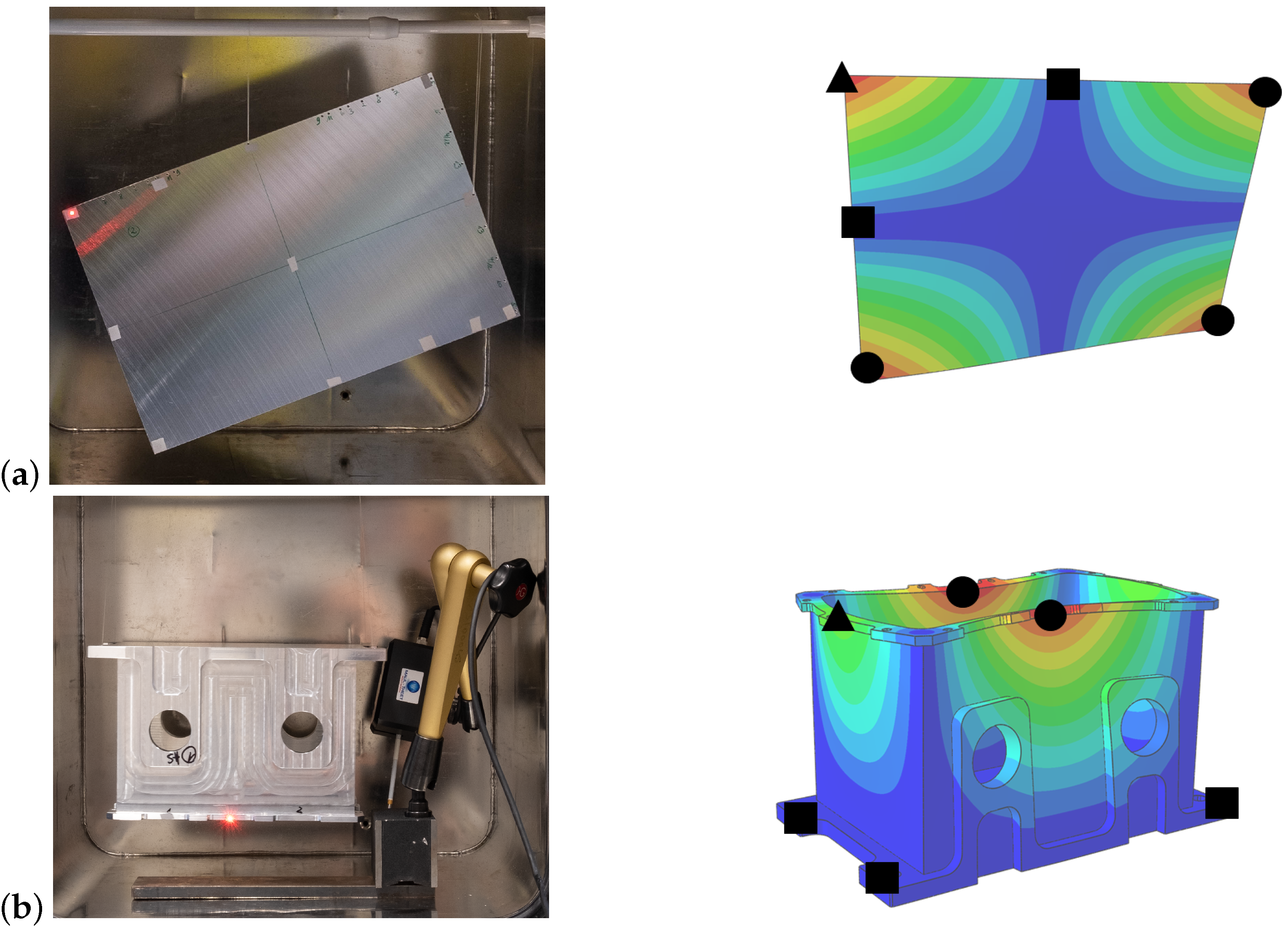
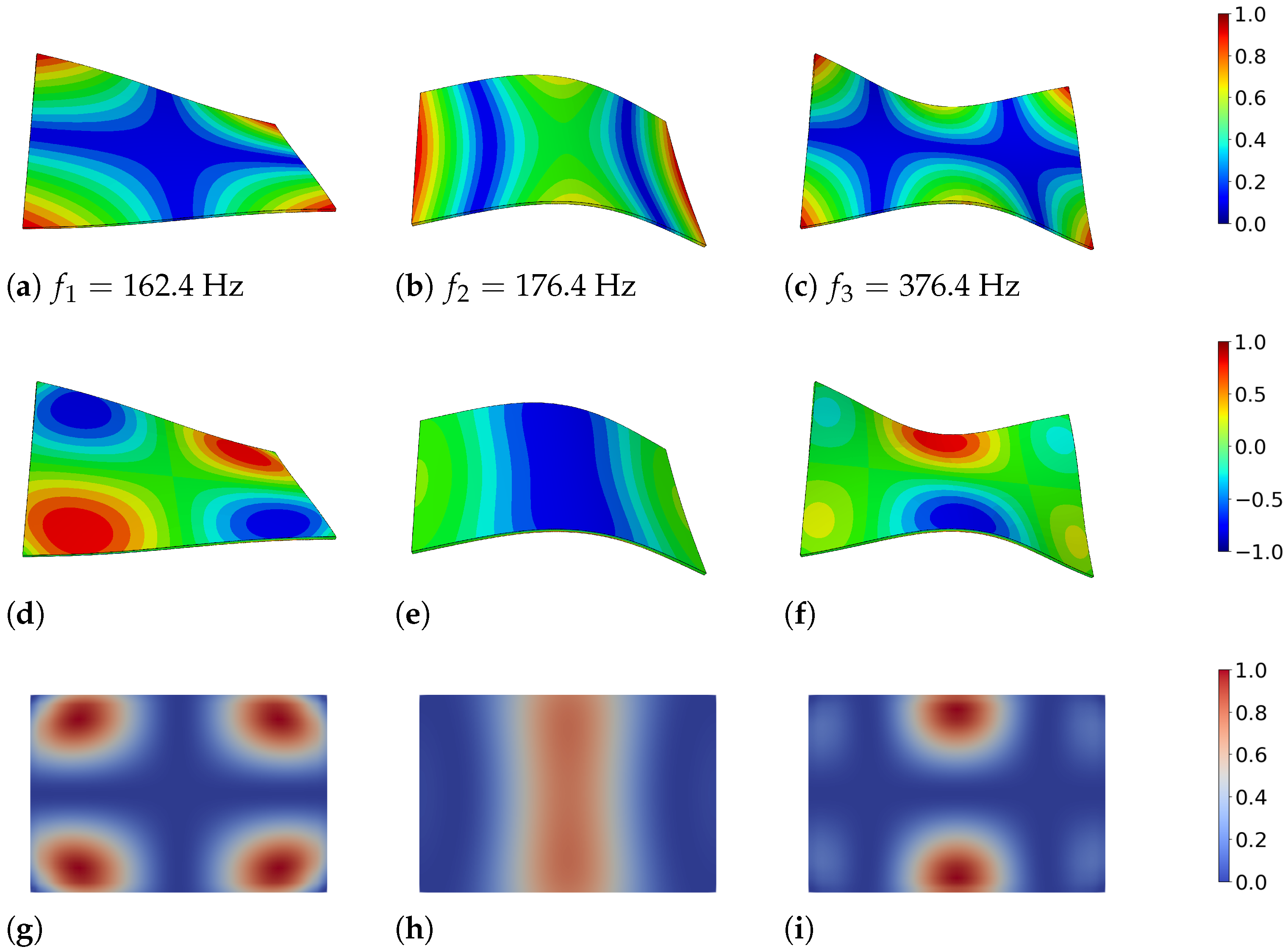
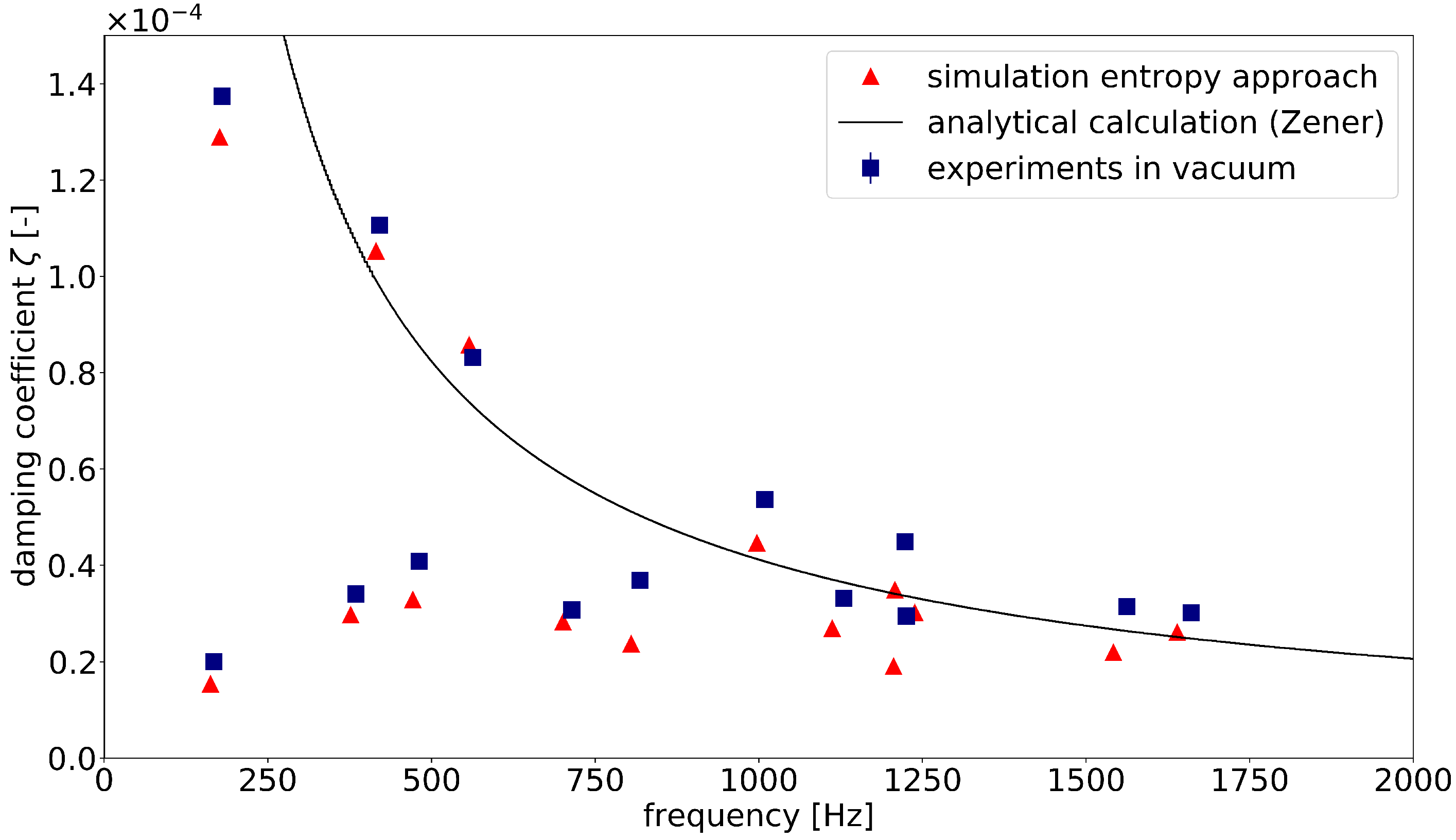
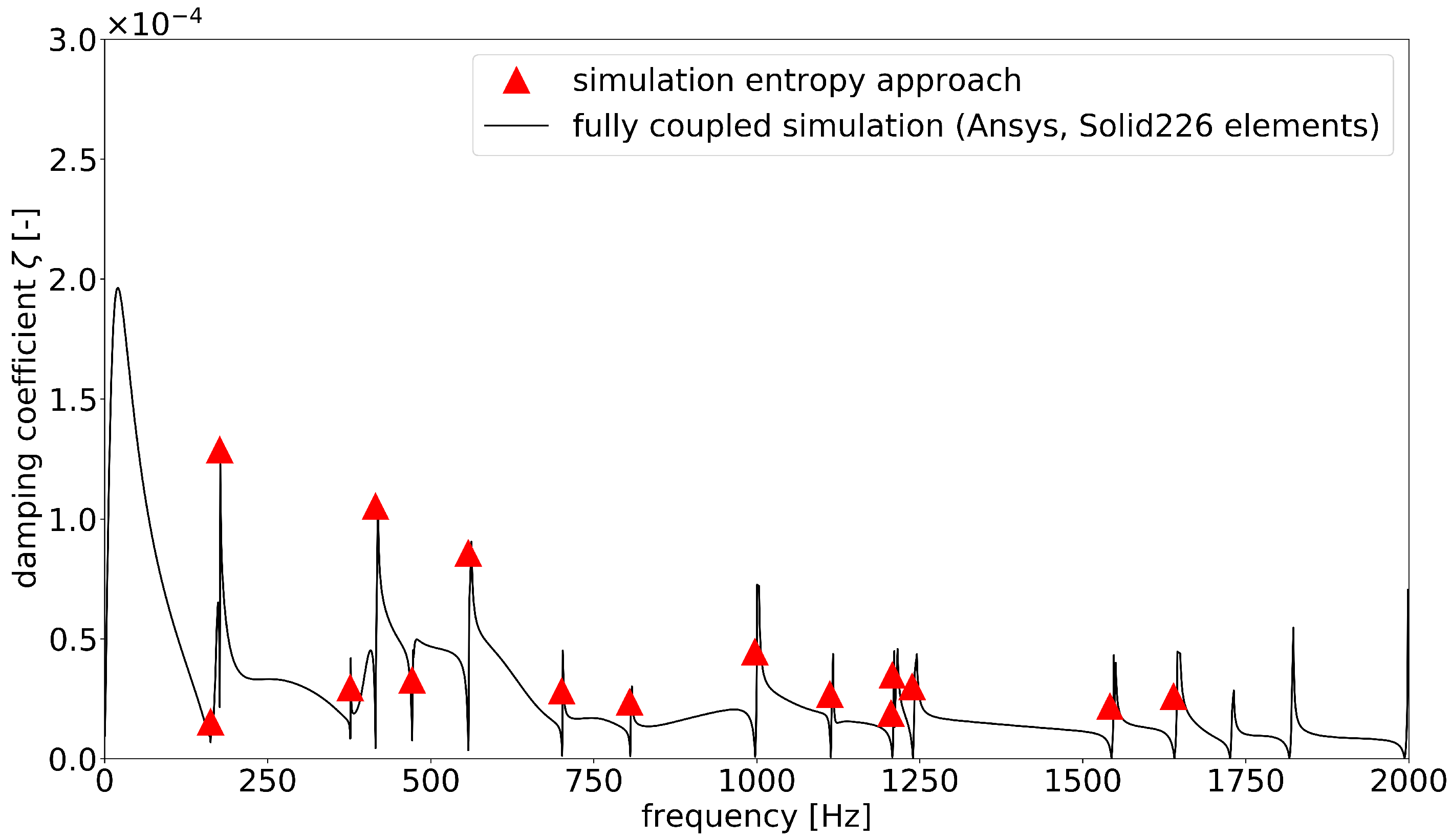

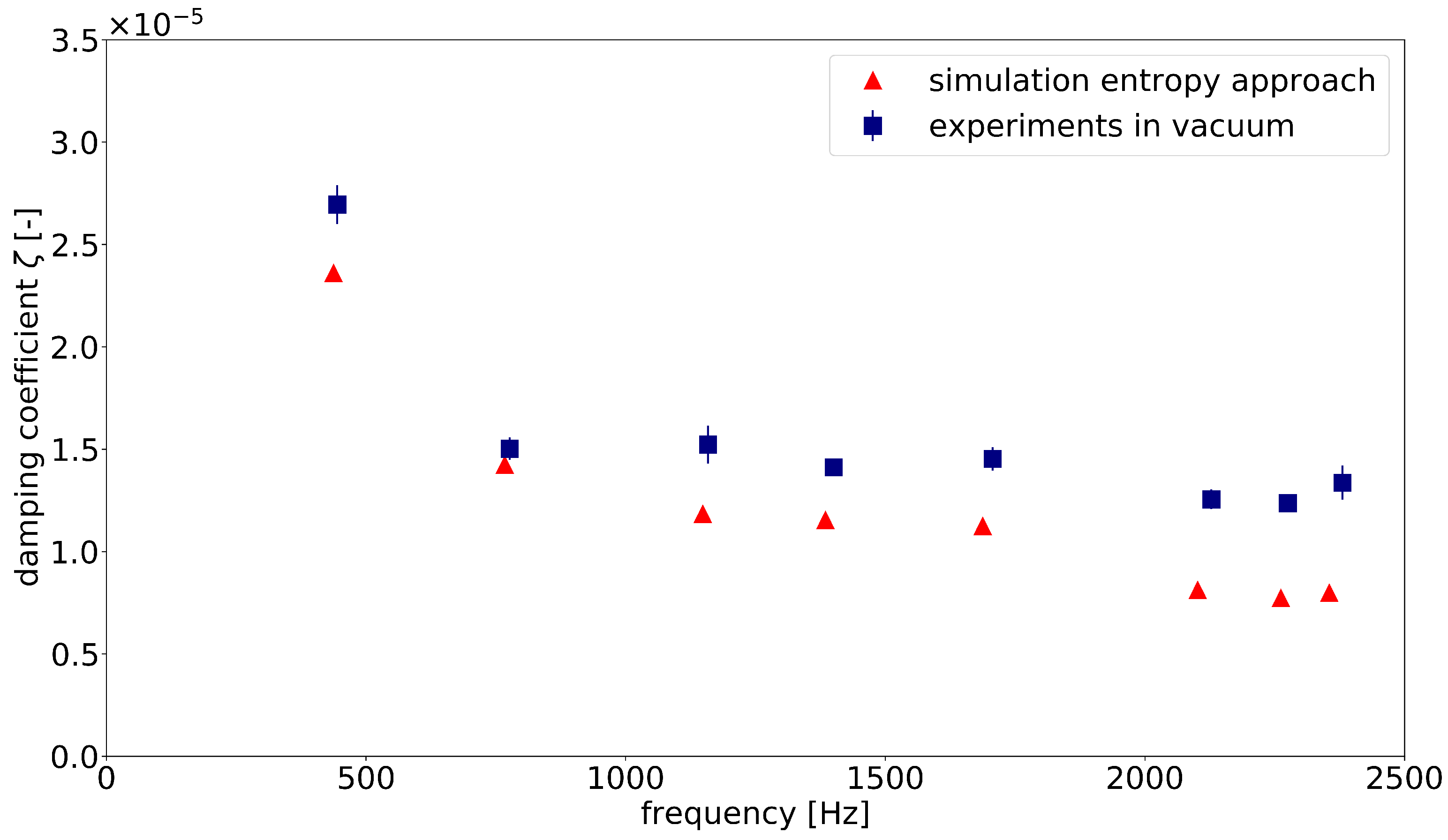
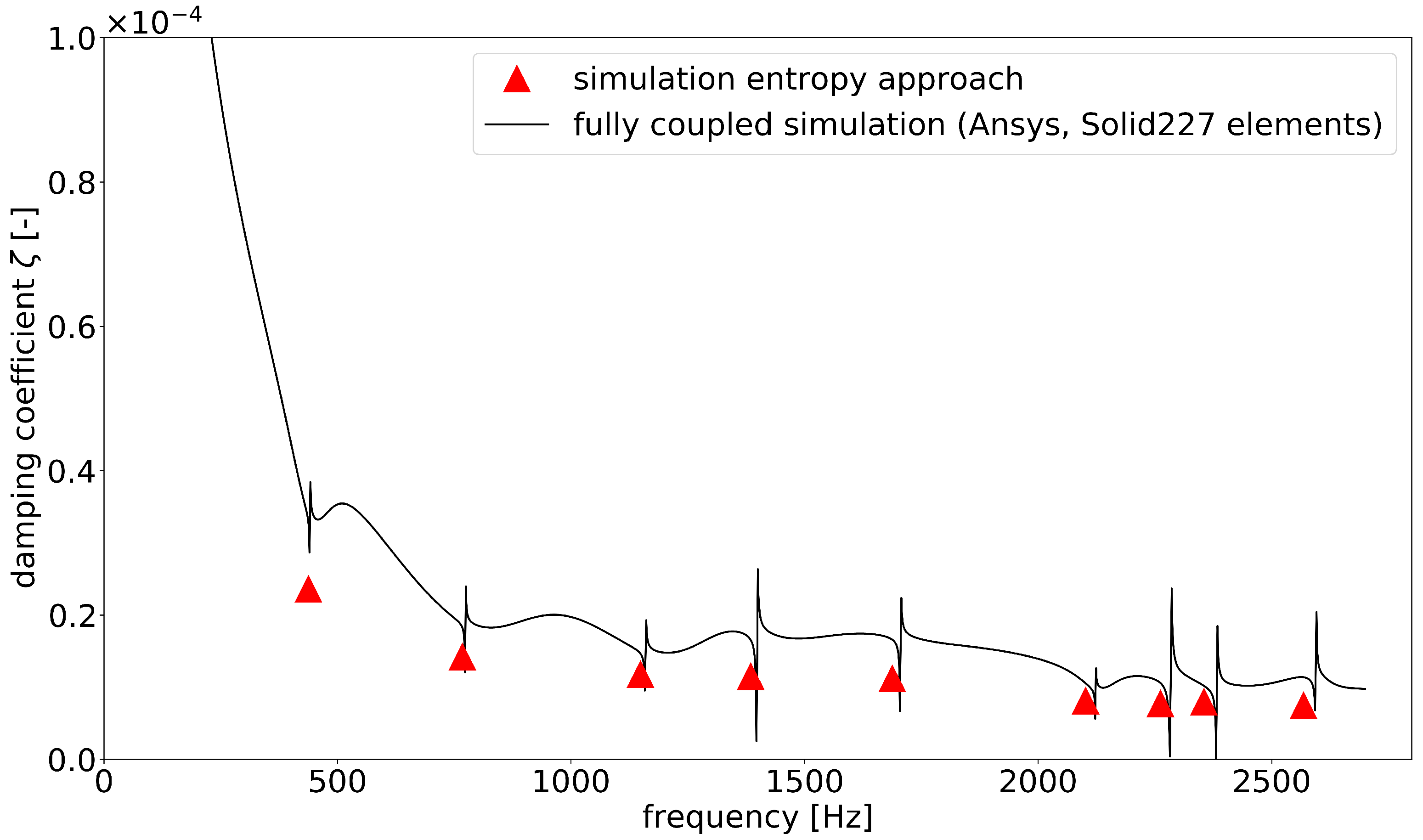
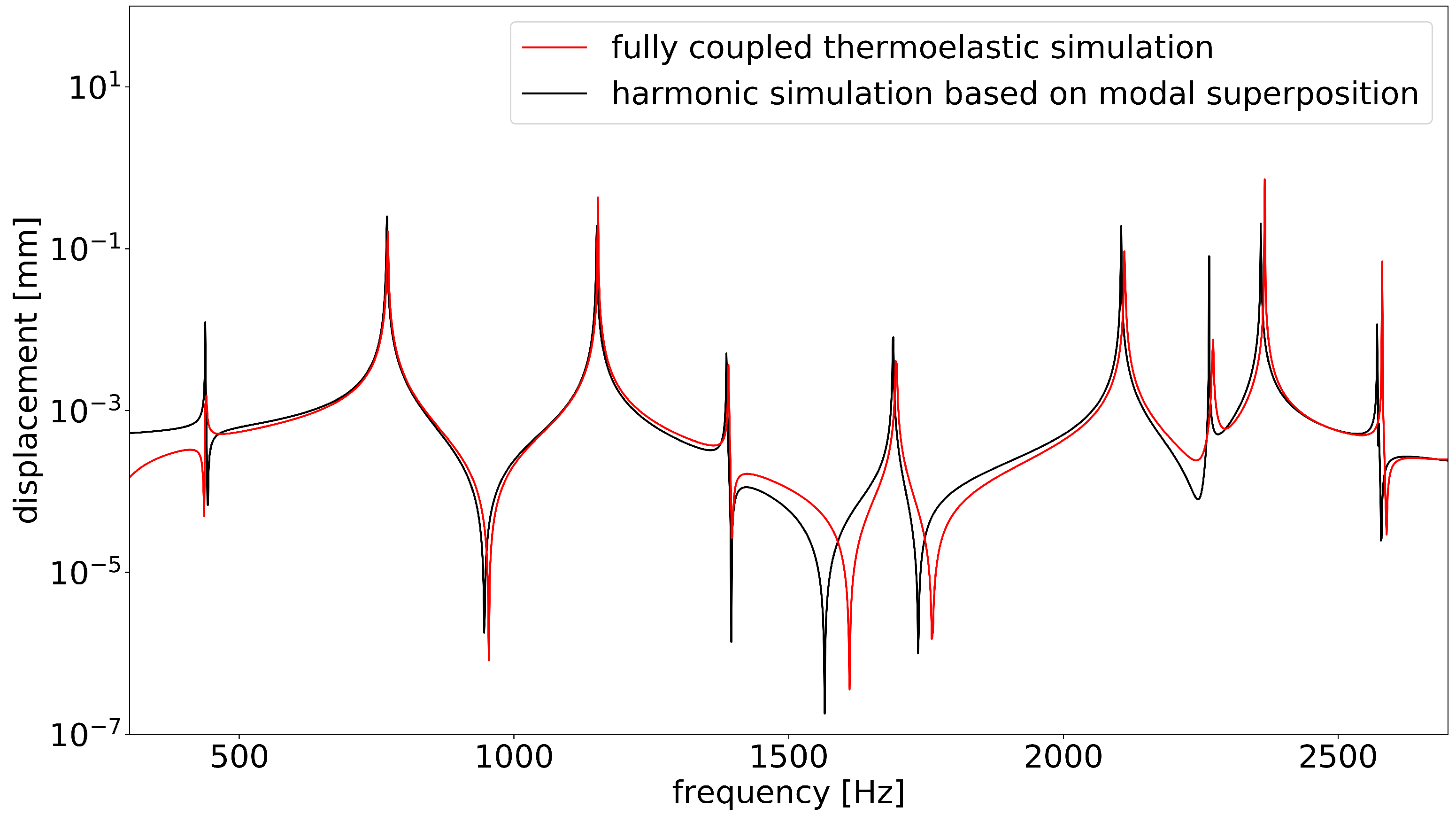
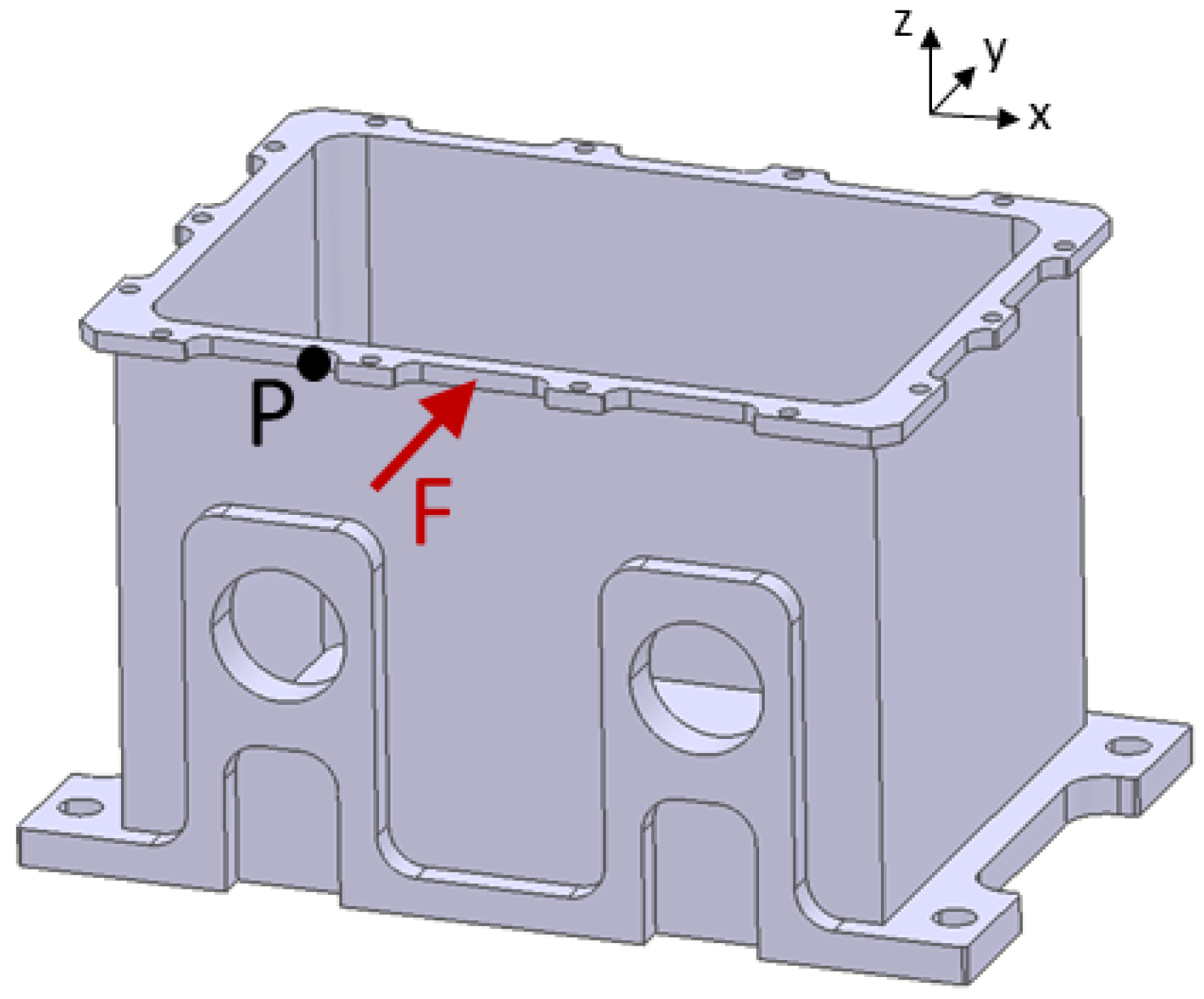

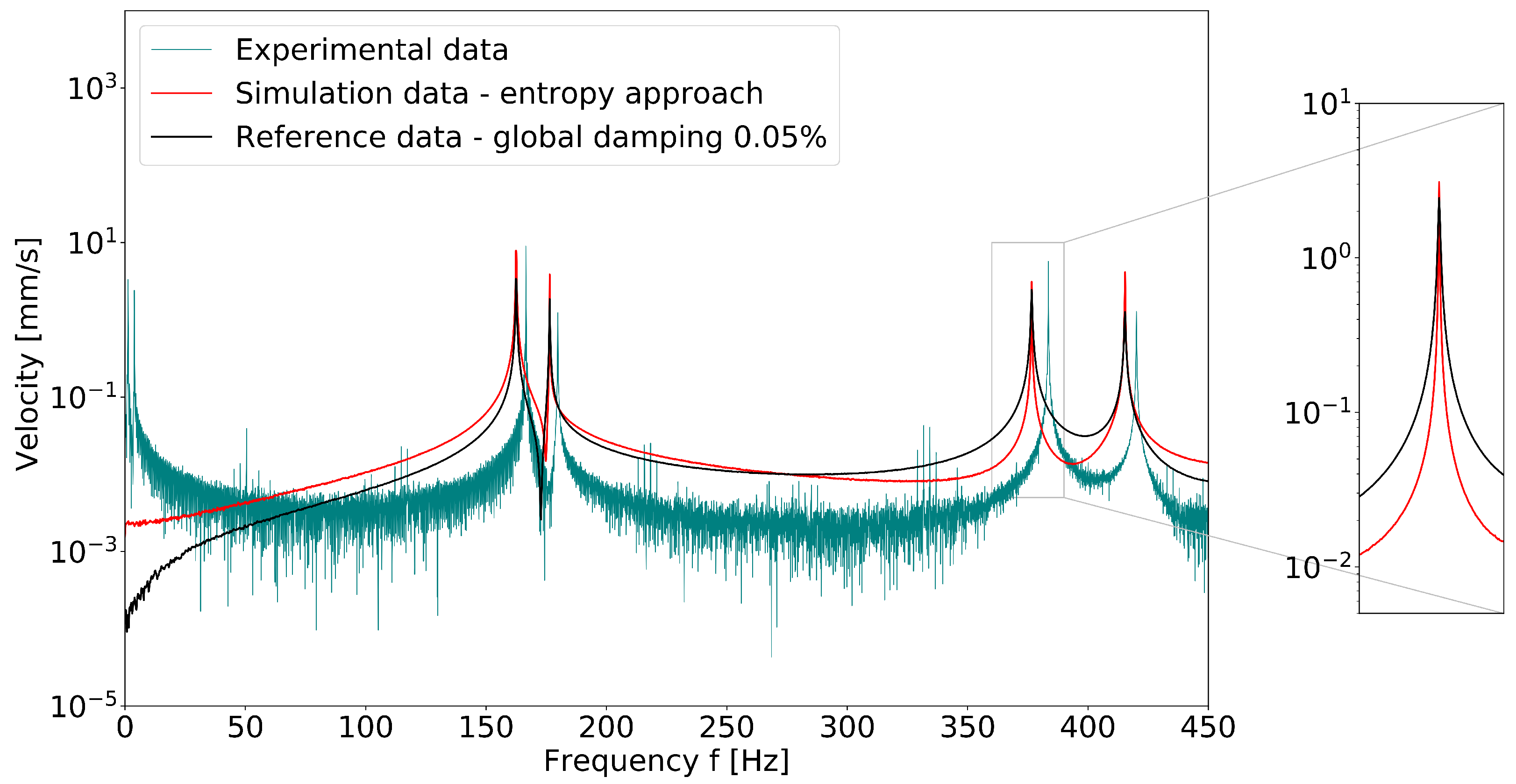
| Parameter | Value | Unit |
|---|---|---|
| Young’s modulus E | ||
| Poisson’s ratio | 0.34 | |
| density | ||
| thermal conductivity | ||
| heat capacity | ||
| thermal expansion coefficient |
| Plate | Box Component | |
|---|---|---|
| number of elements | 9600 el. | 291,320 el. |
| fully coupled simulation SOLID226/227 | 34.8 | 2234.6 |
| (≈6 days) | ||
| entropy approach SOLID186/187 | 16.5 | 35.1 |
| eigenfrequency analysis | 1.2 | 7.5 |
| modal damping coeff. | 9.3 | 17.9 |
| harmonic analysis | 6.0 | 9.7 |
Publisher’s Note: MDPI stays neutral with regard to jurisdictional claims in published maps and institutional affiliations. |
© 2022 by the authors. Licensee MDPI, Basel, Switzerland. This article is an open access article distributed under the terms and conditions of the Creative Commons Attribution (CC BY) license (https://creativecommons.org/licenses/by/4.0/).
Share and Cite
Zacharias, C.; Könke, C.; Guist, C. A New Efficient Approach to Simulate Material Damping in Metals by Modeling Thermoelastic Coupling. Materials 2022, 15, 1706. https://doi.org/10.3390/ma15051706
Zacharias C, Könke C, Guist C. A New Efficient Approach to Simulate Material Damping in Metals by Modeling Thermoelastic Coupling. Materials. 2022; 15(5):1706. https://doi.org/10.3390/ma15051706
Chicago/Turabian StyleZacharias, Christin, Carsten Könke, and Christian Guist. 2022. "A New Efficient Approach to Simulate Material Damping in Metals by Modeling Thermoelastic Coupling" Materials 15, no. 5: 1706. https://doi.org/10.3390/ma15051706
APA StyleZacharias, C., Könke, C., & Guist, C. (2022). A New Efficient Approach to Simulate Material Damping in Metals by Modeling Thermoelastic Coupling. Materials, 15(5), 1706. https://doi.org/10.3390/ma15051706






